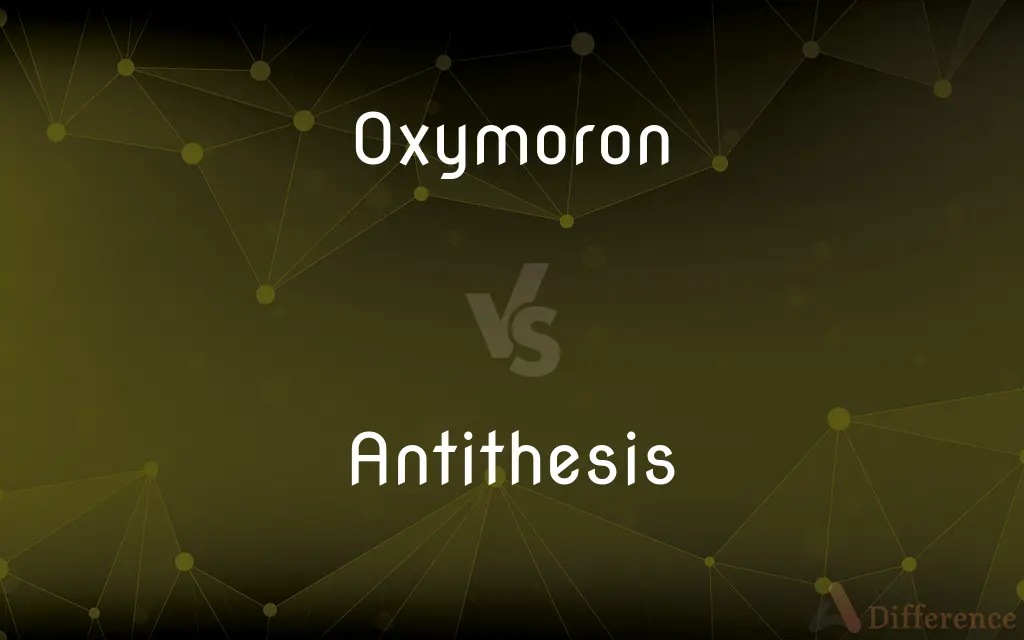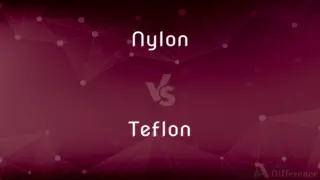Oxymoron vs. Antithesis — What's the Difference?
Edited by Tayyaba Rehman — By Maham Liaqat — Updated on April 14, 2024
An oxymoron combines two contradictory terms for effect (e.g., "deafening silence"), while antithesis juxtaposes contrasting ideas within a parallel structure (e.g., "speech is silver, but silence is golden").

Difference Between Oxymoron and Antithesis
Table of Contents
ADVERTISEMENT
Key Differences
An oxymoron directly fuses contradictory terms to create a new, often paradoxical meaning, as in "jumbo shrimp" or "bitter sweet." In contrast, antithesis relies on the contrast between two ideas or expressions, emphasizing their differences through a balanced or parallel sentence structure, such as in the saying, "It was the best of times, it was the worst of times."
Oxymorons are typically concise, often just two words that seemingly oppose each other but together suggest a deeper or humorous insight. On the other hand, antitheses can span phrases or entire sentences, structuring a clear and often rhetorical opposition between the ideas.
The purpose of using an oxymoron is usually to create a striking or witty effect in a phrase, making the reader think about how the opposites interact. Whereas, antithesis serves to make a point more vivid or memorable by clearly opposing two contrasting thoughts, enhancing the impact through their juxtaposition.
In literature, oxymorons are used to add flavor or a layer of meaning that reflects the complexity of a subject or emotion. Meanwhile, antithesis is often employed in speeches and writing to highlight a philosophical or moral argument, drawing clear distinctions between choices or viewpoints.
Comparison Chart
Definition
A figure of speech combining contradictory terms.
A rhetorical device contrasting opposing ideas in a parallel structure.
ADVERTISEMENT
Structural Complexity
Typically two words.
Often involves phrases or entire sentences.
Usage Purpose
To create paradoxical or humorous effect.
To emphasize contrast for clarity or persuasion.
Common Contexts
Poetry, slogans, everyday speech.
Speeches, formal writing, debates.
Example
"Open secret"
"Man proposes, God disposes."
Compare with Definitions
Oxymoron
A figure of speech that combines contradictory terms to reveal a paradox or humorous effect.
Seriously funny.
Antithesis
Common in persuasive writing and speeches to emphasize differences.
They promised freedom and provided slavery.
Oxymoron
Often appears in literature and poetry to enhance the depth of expression.
Parting is such sweet sorrow.
Antithesis
Strengthens the impact of a message by clearly delineating dichotomies.
Give every man thy ear, but few thy voice.
Oxymoron
Used to express complex or contradictory feelings in a concise way.
Cruel kindness.
Antithesis
Utilized in debates and philosophical discussions to present and evaluate contrasting theories.
Absence sharpens love, presence strengthens it.
Oxymoron
Can be used in everyday language to convey irony or wit.
Act naturally.
Antithesis
A rhetorical device that contrasts two ideas using a parallel grammatical structure.
Easy on the eyes, hard on the heart.
Oxymoron
Adds a layer of meaning by juxtaposing opposing concepts.
Living death.
Antithesis
Employed to enhance the clarity of an argument by outlining opposing viewpoints.
To err is human; to forgive, divine.
Oxymoron
An oxymoron (usual plural oxymorons, more rarely oxymora) is a figure of speech that juxtaposes concepts with opposing meanings within a word or phrase that creates an ostensible self-contradiction. An oxymoron can be used as a rhetorical device to illustrate a rhetorical point or to reveal a paradox.
Antithesis
Antithesis (Greek for "setting opposite", from ἀντί "against" and θέσις "placing") is used in writing or speech either as a proposition that contrasts with or reverses some previously mentioned proposition, or when two opposites are introduced together for contrasting effect. This is based on the logical phrase or term.Antithesis can be defined as "a figure of speech involving a seeming contradiction of ideas, words, clauses, or sentences within a balanced grammatical structure.
Oxymoron
A rhetorical figure in which incongruous or contradictory terms are combined, as in a deafening silence and a mournful optimist.
Antithesis
Direct contrast; opposition.
Oxymoron
(rhetoric) A figure of speech in which two words or phrases with opposing meanings are used together intentionally for effect.
Antithesis
The direct or exact opposite
Hope is the antithesis of despair.
Oxymoron
A contradiction in terms.
Antithesis
A figure of speech in which sharply contrasting ideas are juxtaposed in a balanced or parallel phrase or grammatical structure, as in "Hee for God only, shee for God in him" (John Milton).
Oxymoron
A figure in which an epithet of a contrary signification is added to a word; e. g., cruel kindness; laborious idleness.
Antithesis
The second and contrasting part of such a juxtaposition.
Oxymoron
Conjoining contradictory terms (as in `deafening silence')
Antithesis
The second stage of the Hegelian dialectic process, representing the opposite of the thesis.
Antithesis
A proposition that is the diametric opposite of some other proposition.
Antithesis
(rhetoric) A device by which two contrasting ideas are juxtaposed in parallel form; a figure of speech arranged in this manner
Antithesis
An opposition or contrast of words or sentiments occurring in the same sentence; as, "The prodigal robs his heir; the miser robs himself." "He had covertly shot at Cromwell; he how openly aimed at the Queen."
Antithesis
The second of two clauses forming an antithesis.
Antithesis
Opposition; contrast.
Antithesis
Exact opposite;
His theory is the antithesis of mine
Antithesis
The juxtaposition of contrasting words or ideas to give a feeling of balance
Common Curiosities
How does antithesis enhance rhetoric?
Antithesis enhances rhetoric by clearly opposing two ideas, which strengthens the persuasiveness or memorability of a point.
What is the main difference between an oxymoron and antithesis?
An oxymoron combines contradictory terms into a single expression, while antithesis contrasts two ideas within a parallel grammatical structure.
Are oxymorons always humorous?
Not always; oxymorons can also convey a deep or poignant contradiction, depending on the context.
Is antithesis only used in literature?
No, antithesis is widely used in public speaking, advertising, and any context where contrasting ideas need to be emphasized.
What is an example of antithesis in political speeches?
A famous example is from John F. Kennedy's inaugural address: "Ask not what your country can do for you—ask what you can do for your country."
How does the use of oxymorons reflect on a speaker's language skills?
Employing oxymorons effectively can demonstrate a speaker’s cleverness and ability to engage with language creatively.
Can antithesis be used to resolve conflicts?
While it highlights differences, antithesis can also be used rhetorically to guide towards a synthesis or resolution by clearly defining the terms of the debate.
Can an oxymoron be a form of irony?
Yes, oxymorons can be ironic, especially when the contradiction between the words plays on expectations versus reality.
Can oxymorons be more than two words?
Typically, oxymorons are two words, but they can occasionally extend to short phrases that maintain the contradictory concept.
How do writers benefit from using oxymorons?
Writers use oxymorons to add depth to their descriptions and to help readers see nuances in their characters or themes.
What role does antithesis play in poetry?
In poetry, antithesis can create rhythm and highlight emotional conflicts or philosophical debates within the poem.
Why might a speaker use antithesis in a debate?
In debates, using antithesis helps clarify the differences between opposing viewpoints, making arguments clearer and more persuasive.
How can understanding these figures of speech improve communication?
Recognizing and using figures like oxymorons and antitheses can make communication more effective by adding clarity, emphasis, or subtlety.
What are common pitfalls when using antithesis?
Overusing antithesis can make writing seem contrived or overly simplistic, especially if the contrasts are forced or overly obvious.
What is a simple example of an oxymoron in advertising?
“Freezer burn” is an oxymoron used to describe the effect of freezing on food, which combines the ideas of freezing and burning.
Share Your Discovery

Previous Comparison
Pushpit vs. Pulpit
Next Comparison
Nylon vs. TeflonAuthor Spotlight
Written by
Maham LiaqatEdited by
Tayyaba RehmanTayyaba Rehman is a distinguished writer, currently serving as a primary contributor to askdifference.com. As a researcher in semantics and etymology, Tayyaba's passion for the complexity of languages and their distinctions has found a perfect home on the platform. Tayyaba delves into the intricacies of language, distinguishing between commonly confused words and phrases, thereby providing clarity for readers worldwide.















































